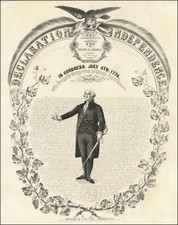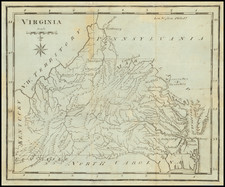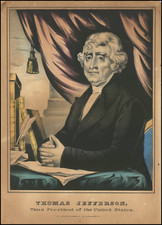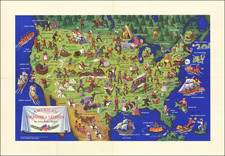"[T]here will be NO NEGRO DOMINATION with MEN and WOMEN VOTING."
Important persuasive political map arguing in favor of the ratification of the 19th Amendment by Virginia and attempting to assuage local concerns that the Amendment would result in an end to "White Supremacy" in the Commonwealth and increase in the Socialist vote. The map was issued by the Equal Suffrage League of Virginia along with the National American Woman Suffrage Association (both spelled "Suffage" in the imprint line).
The map makes its case for the Amendment by pointing out that Thomas Jefferson and James Madison, both native Virginians, were in favor of amending the Constitution as needed. It also notes that the ratification of the 19th Amendment is "inevitable" because there is no time limit on the necessary three-fourths of state legislatures ratifying an amendment and 21 states had already done so for the 19th.
This latter point relates to the map of the United States at the top of the broadside, which shows that many states (especially those in the West) had already granted women full suffrage, while still others had granted it for things like primaries, school bonds and taxes, presidential elections, and municipal suffrage. Stars indicate the states which had already ratified the 19th Amendment.
The map is clear that although the 19th Amendment would result in a major change in the way politics are conducted in the Commonwealth, it would not upend other fundamental political realities in Virginia at the time; namely, it would not undermine "White Supremacy" nor would it result in "the Socialist vote being increased by the woman vote".
"White Supremacy."
The 19th Amendment was resisted in South in part because it was seen as a step towards universal enfranchisement and the end to the anti-Reconstruction Amendment laws (Jim Crow). Those laws had enabled continued white rule in areas of the South where whites were in the minority. The map sums up the position of the Equal Suffrage League of Virginia with respect to "white supremacy":
There is NOW no negro domination UNDER MALE SUFFRAGE in the counties in Virginia where white people are in the minority, and there will be NO NEGRO DOMINATION with MEN and WOMEN VOTING. The SAME STATE RESTRICTIONS which NOW APPLY to the MAN VOTER will also APPLY TO THE WOMAN VOTER, with the Federal Suffrage Amendment has been ratified.
In the introductory paragraphs the issue is also alluded to:
Therefore the Federal Suffrage Amendment does away with SEX discrimination--IT DOES NOT remove ANY OTHER QUALIFICATION for voters established by ANY State.
It is most clearly spelled out in the following paragraph:
Because the Federal Suffrage Amendment, when in operation can only prevent the States from disfranchising ALL women "because THEY ARE WOMEN." But it CANNOT prevent the States from imposing such RESTRICTIONS upon WOMAN'S VOTE as EACH STATE NOW IMPOSES upon the MAN'S VOTE, namely, the POLL TAX, RESIDENTIAL QUALIFICATION and the ABILITY TO READ and WRITE.
"Women Are Conservative"
The other main concern addressed by the broadside is the belief that women voters would shift the politics of the Commonwealth to the left.
The anti-suffragists need have no fear of the Socialist vote being increased by the woman vote.
The section notes that out of the 408,671 women voters enrolled in New York City in 1918, only 5 percent were enrolled with the Socialist Party, while 54 percent were registered Democrats.
In this matter they were correct; in the 1920 Presidential Election, the first after the passage of the 19th Amendment, Eugene V. Debs received only 807 votes, or .35% of the total cast, whereas the Democratic candidate James M. Cox received 61.32%.
Rarity
The map appeared in a variety of formats and although OCLC does not record any examples, a number can be found online. However, the present version, with the extensive important text below the map image, appears to be extremely rare and we can trace no other examples, either in institutions or on the market.
Conclusion
Despite its active campaign, the Equal Suffrage League of Virginia failed to win over enough Virginians, and on February 12, 1920, Virginia voted against ratifying the 19th Amendment. It mattered not, however, as by August of 1920 36 states approved the proposal and the 19th Amendment became law all across the country – even in Virginia.
On February 21, 1952, Virginia showed its support for women’s suffrage by officially ratifying the 19th Amendment.
Appendix: The Equal Suffrage League of Virginia
The Library of Virginia has published the following overview of the ESL:
The Equal Suffrage League of Virginia (ESL) was founded in 1909 in Richmond. The ESL became one of the most influential suffrage organizations in the country. Among the twenty founding women, Lila Meade Valentine, a Richmond native, was elected the league's first president. The league's members included several prestigious women, Ellen Glasgow, Mary Johnston, Adéle Clark, Nora Houston, and Dr. Katherine Waller Barrett. During the league's first year, almost 120 members joined, most of them residents of Richmond. Recruiting new members initially proved difficult. Among the obstacles league members met with were the objections of fathers to their daughters participating in the league and women with a lack of knowledge on the subject of or interest in woman suffrage.
From the beginning the ESL faced enormous challenges that well-established organizations, such as the National American Woman Suffrage Association, had already met. Virginia women needed to start an education campaign that would bring public awareness to the issue of woman suffrage. In an effort to spread the word for woman suffrage, member writer Mary Johnston spoke at women's colleges and Valentine gave more than 100 speeches across Virginia encouraging suffrage support. Other members did their part by visiting schools, fairs, and union meetings and distributing materials on city streets. These strategies worked. By 1911, membership had grown to 290, and by 1919 to 30,000 and with numerous branches across Virginia.
Although progress was made, the women of the ESL confronted additional challenges when groups like the Virginia Association Opposed to Woman Suffrage (VAOWS) formed in opposition to the cause. The VAOWS used racist and political arguments to promote antisuffrage, claiming that woman suffrage would destroy state's rights and often drawing parallels between it and the Fifteenth Amendment, which gave black men the right to vote. One of the most prominent arguments that antisuffrage organizations made was that if black women were allowed to vote it would endanger white supremacy. This could potentially explain why nine of the ten states that initially refused to ratify the Nineteenth Amendment were in the South.
The Equal Suffrage League expanded its objectives to appeal to more women. Instead of simply promoting the vote for women, the league examined all aspects of women's lives and called attention to the inequality women faced legally, socially, and economically. Adopting truly feminist ideals, the ESL helped paved the way for woman's rights campaigns in the future. In spite of these progressive ideals, traditions in Virginia proved too difficult to break both socially and politically early in the twentieth century. The General Assembly refused to submit a state woman suffrage constitutional amendment to the voters, and it was not until 32 years after the Nineteenth Amendment was ratified that the assembly ratified the amendment.










![[Early Montana Territory Shown Above Idaho] Johnson's New Military Map of the United States Forts, Military Posts & all the Military Divisions with Enlarged Plans of the Southern Harbors . . . (Shows Military Departments)](https://storage.googleapis.com/raremaps/img/small/93868.jpg)



